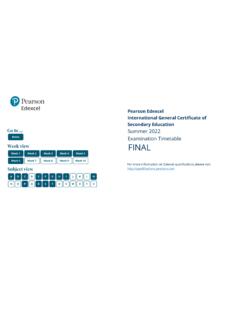Transcription of 0625 s16 ms 41 - IGCSE Past Papers
1 IGCSE is the registered trademark of Cambridge International Examinations. This syllabus is approved for use in England, Wales and Northern Ireland as a Cambridge International Level 1/Level 2 Certificate. This document consists of 11 printed pages. UCLES 2016 [Turn over Cambridge International Examinations Cambridge International General Certificate of Secondary Education physics 0625/41 Paper 4 Extended Theory May/June 2016 MARK SCHEME Maximum Mark: 80 Published This mark scheme is published as an aid to teachers and candidates, to indicate the requirements of the examination.]
2 It shows the basis on which Examiners were instructed to award marks. It does not indicate the details of the discussions that took place at an Examiners meeting before marking began, which would have considered the acceptability of alternative answers. Mark schemes should be read in conjunction with the question paper and the Principal Examiner Report for Teachers. Cambridge will not enter into discussions about these mark schemes. Cambridge is publishing the mark schemes for the May/June 2016 series for most Cambridge IGCSE , Cambridge International A and AS Level components and some Cambridge O Level components.
3 2 Mark Scheme Syllabus Paper Cambridge IGCSE May/June 2016 0625 41 Cambridge International Examinations 2016 NOTES ABOUT MARK SCHEME SYMBOLS AND OTHER MATTERS M marks are method marks upon which further marks depend. For an M mark to be scored, the point to which it refers must be seen in a candidate's answer. If a candidate fails to score a particular M mark, then none of the dependent marks can be scored. B marks: are independent marks, which do not depend on other marks. For a B mark to scored, the point to which it refers must be seen specifically in the candidate s answers.
4 A marks In general A marks are awarded for final answers to numerical questions. If a final numerical answer, eligible for A marks, is correct, with the correct unit and an acceptable number of significant figures, all the marks for that question are normally awarded. It is very occasionally possible to arrive at a correct answer by an entirely wrong approach. In these rare circumstances, do not award the A marks, but award C marks on their merits. However, correct numerical answers with no working shown gain all the marks available.
5 C marks are compensatory marks in general applicable to numerical questions. These can be scored even if the point to which they refer are not written down by the candidate, provided subsequent working gives evidence that they must have known it. For example, if an equation carries a C mark and the candidate does not write down the actual equation but does correct substitution or working which shows he knew the equation, then the C mark is scored A C marks is not awarded if a candidate makes two points which contradict each other.
6 Points which are wrong but irrelevant are ignored. brackets ( ) around words or units in the mark scheme are intended to indicate wording used to clarify the mark scheme, but the marks do not depend on seeing the words or units in brackets. 10 (J) means that the mark is scored for 10, regardless of the unit given. underlining indicates that this must be seen in the answer offered, or something very similar. OR / or indicates alternative answers, any one of which is satisfactory for scoring the marks.
7 Means "each error or omission". means or words to that effect . Spelling Be generous about spelling and use of English. If an answer can be understood to mean what we want, give credit. However, beware of and do not allow ambiguities, accidental or deliberate: spelling which suggests confusion between reflection / refraction / diffraction / thermistor / transistor / transformer. Not/NOT Indicates that an incorrect answer is not to be disregarded, but cancels another otherwise correct alternative offered by the candidate right plus wrong penalty applies.
8 Ignore Indicates that something which is not correct or irrelevant is to be disregarded and does not cause a right plus wrong penalty. 3 Mark Scheme Syllabus Paper Cambridge IGCSE May/June 2016 0625 41 Cambridge International Examinations 2016 ecf meaning "error carried forward" is mainly applicable to numerical questions, but may in particular circumstances be applied in non-numerical questions. This indicates that if a candidate has made an earlier mistake and has carried an incorrect value forward to subsequent stages of working, marks indicated by ecf may be awarded, provided the subsequent working is correct, bearing in mind the earlier mistake.
9 This prevents a candidate being penalised more than once for a particular mistake, but only applies to marks annotated ecf. Significant Answers are normally acceptable to any number of significant figures 2. Any Figures exceptions to this general rule will be specified in the mark scheme. Units Deduct one mark for each incorrect or missing unit from an answer that would otherwise gain all the marks available for that answer: maximum 1 per question. No deduction is incurred if the unit is missing from the final answer but is shown correctly in the working.
10 Arithmetic errors Deduct one mark if the only error in arriving at a final answer is clearly an arithmetic one. Transcription Deduct one mark if the only error in arriving at a final answer is because given or errors previously calculated data has clearly been misread but used Fractions ( ) Allow these only where specified in the mark scheme. Crossed out work Work which has been crossed out and not replaced but can easily be read, should be marked as if it had not been crossed out. Use of NR (# key on the keyboard) Use this if the answer space for a question is completely blank or contains no readable words, figures or symbols.








